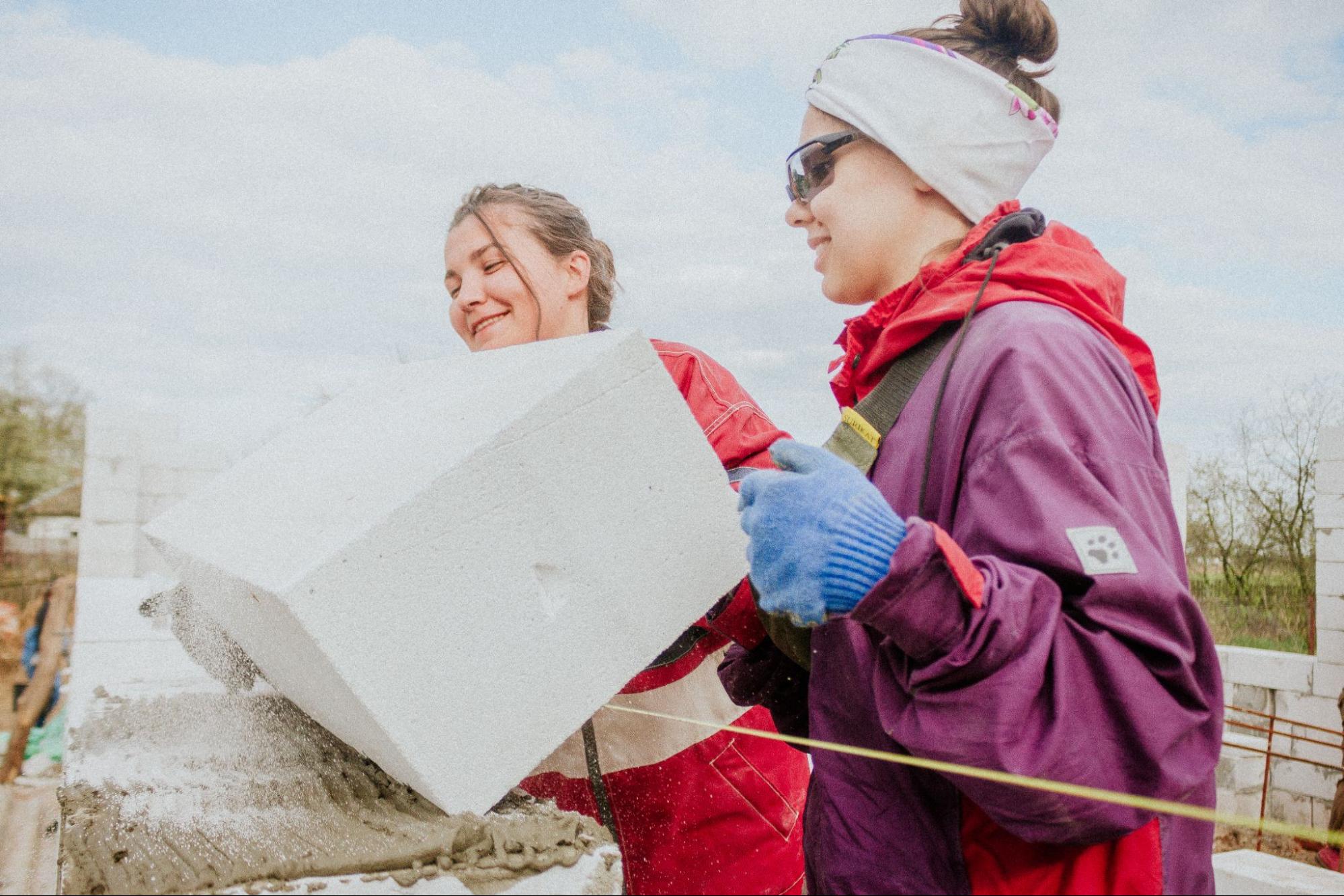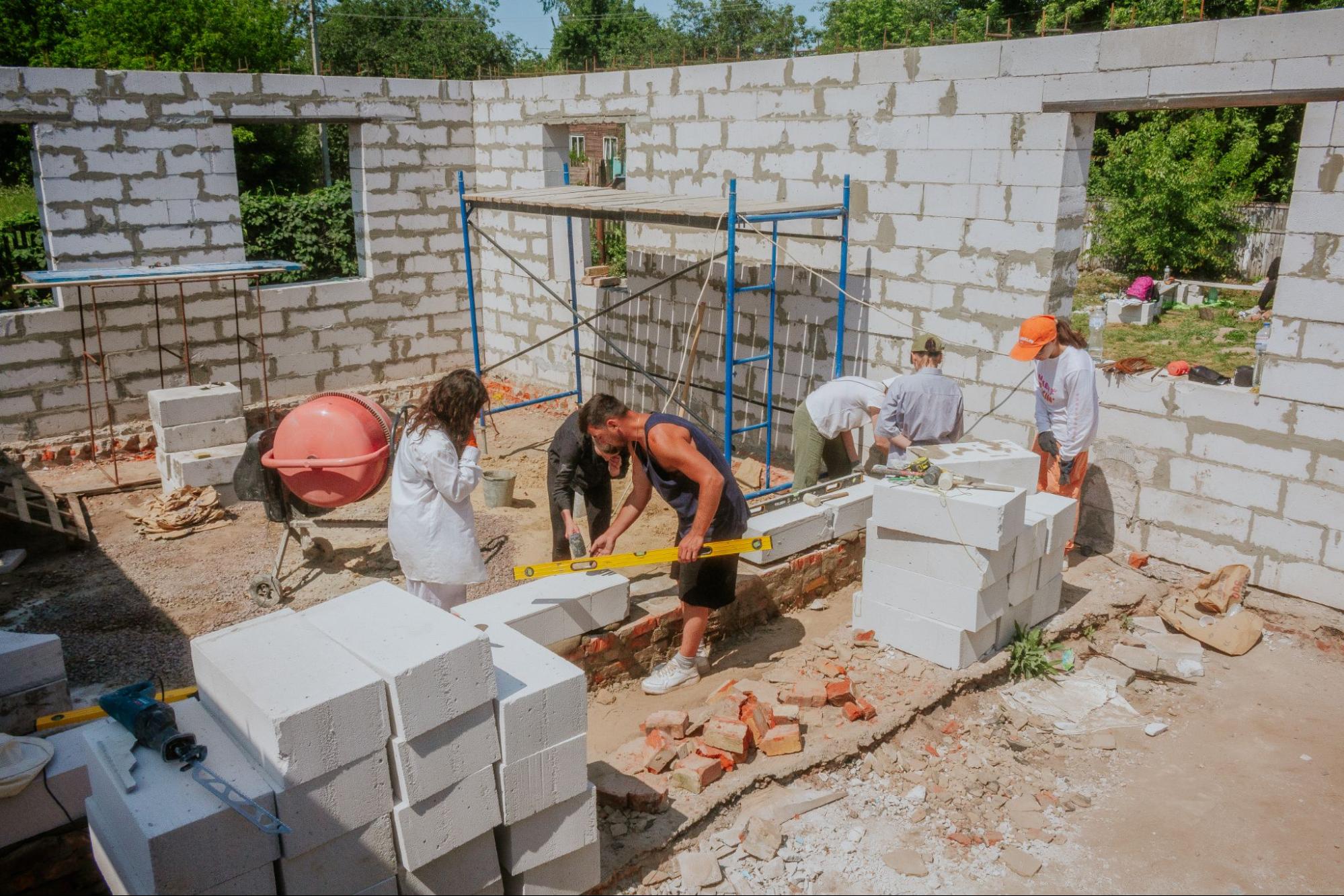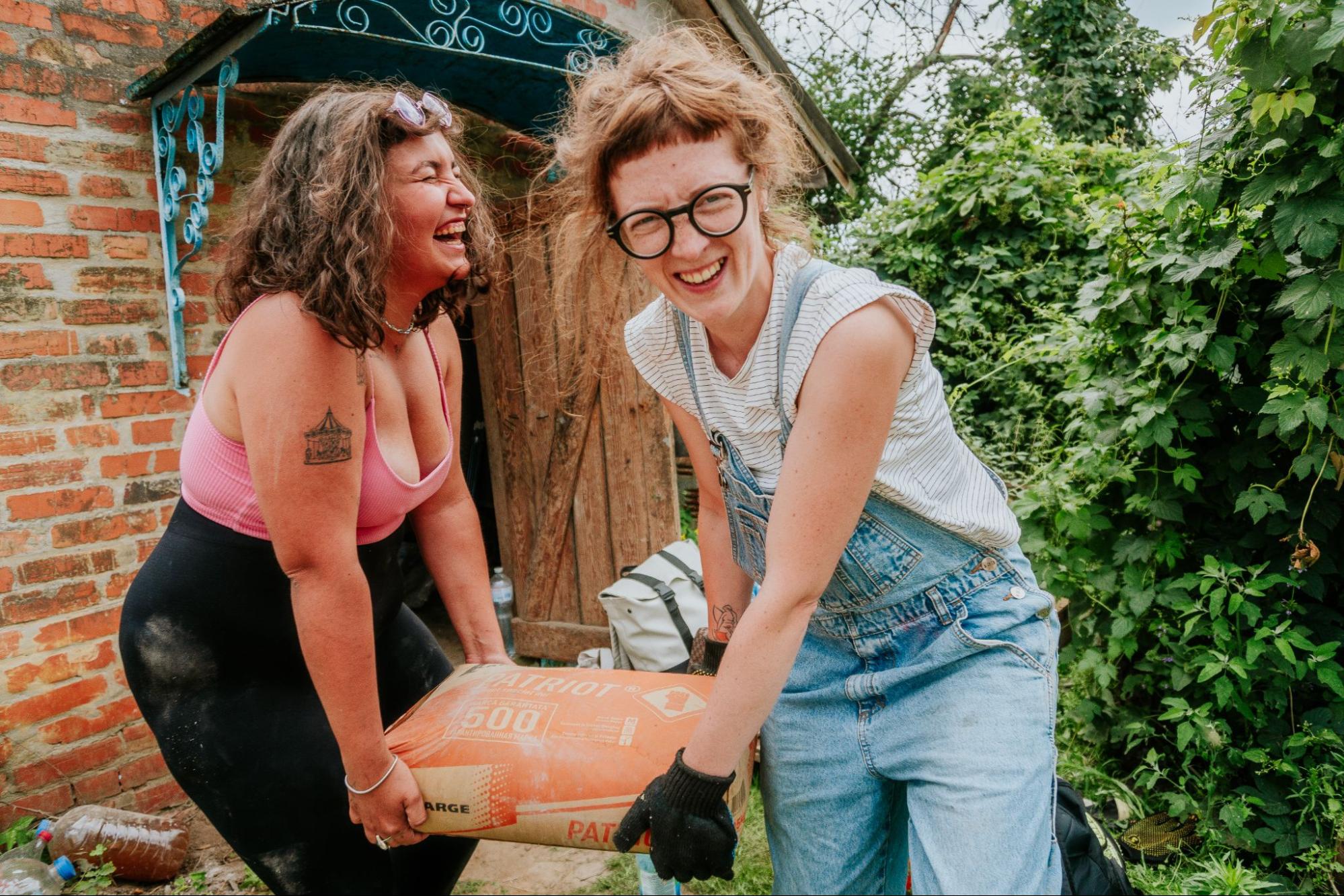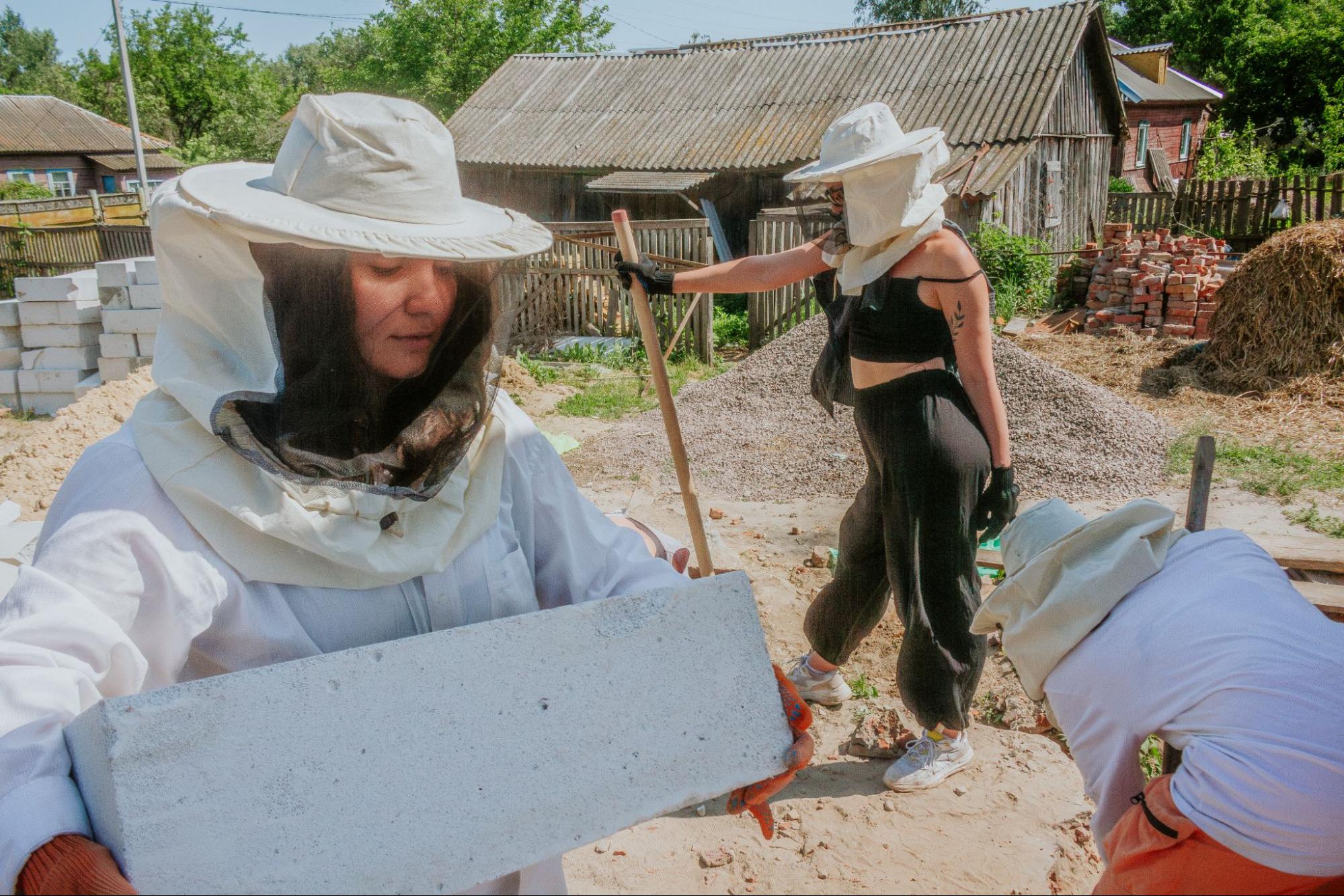This story originally appeared in Rubryka, a Ukrainian digital publication.
In April 2022, a little over one month after Russia launched its large-scale invasion of Ukraine, the Russian forces finally retreated from the northern Chernihiv region, leaving behind thousands of destroyed homes and lives. Realizing that their attempt to capture the area had failed, Russians tried to flatten it to the ground, shelling and bombing civilian homes from Russia’s territory.
That’s when the initiative Repair Together was born. Today, it has brought together over 4,000 volunteers who help clear the destruction debris and rebuild homes for those affected in the Chernihiv region.
Volunteers came from across Ukraine and worldwide because an active position in helping others transcends gender, race, nationality or other factors. However, what surprised many women volunteers was that some people still judged them based on outdated stereotypes.
“We were doing repairs, providing targeted aid, grabbing onto any work we could,” says Daria Kosiakova, co-founder of the initiative. “In our community, there was always 50/50 between men and women at the cleanup events, and at some point, there were even more women. But when it came to construction, men — the professional foremen we had to hire since there were no professional builders among us — ended up dominating the space.”
Daria says that’s when the discrimination incidents began: “They didn’t teach the women any tasks besides plastering holes. On top of that, they’d make remarks like, ‘Women at a construction site are like women on a ship — not needed,’ or make jokes about women belonging in the kitchen.”
Women, seen as more delicate, were often shielded from tasks or treated protectively: “You’ll get hurt here,” “This will be too hard for you,” or “You don’t need to do that.”
“In situations like these, a woman either faces aggression, as if she’s unwanted there, or she feels like a child,” Daria explains.
Incidents like these slow down the work because instead of everyone moving forward, time is wasted on debates about who belongs on the construction site and who doesn’t. When, in fact, everyone should and can contribute to Ukraine’s defense and recovery.
The initiative’s co-founders, Daria Kosiakova and Vika Afanasieva, decided it was time to break all stereotypes and prove that women had a place at construction sites. This idea gave birth to the project Velyke Divnytstvo (“The Great Women’s Build”), in which an all-female team independently builds homes.
Daria adds that beyond honoring their values, co-founders wanted this project to be a safe space for women to learn and develop construction skills if they wish to: “I can confidently say this is a place where no one is surprised or scared if you don’t know how to do something. They’ll show you how, and you’ll pick it up.”

Velyke Divnytstvo is not about distancing from men; it’s about proving that everyone is equal. “When we talk about gender equality, I believe it’s wrong to say that women can’t do physical work because they need to bear children,” the volunteer reflects. “It’s just as wrong to tell men they aren’t men if they aren’t strong. For some reason, society worries about women’s wombs but not about men’s backs or hernias. We wanted to make construction unisex, where we’re all just people.”
The team strives to make construction at Repair Together inclusive and supportive of everyone’s needs. For instance, if a woman is on her period, she can mention it without hesitation, and everyone will understand. Likewise, if a man isn’t feeling well, he can step back from heavy tasks for the day.
Currently, Repair Together is rebuilding 16 homes, five of which are already occupied. The local community provides the list of those needing help, but after a few unpleasant incidents, the team now personally verifies the homeowners before starting reconstruction.
“In 2022, we were deciding whose homes to rebuild. We were finalizing the list of homes to rebuild when we found out, purely by chance, that one family had lied to us. Their son had recently bought a house for $20,000, yet they claimed they had nowhere to live. After that, Vika came up with the ‘five neighbors rule,’ where we now visit neighbors and verify the information before we proceed,” Daria explains.
Weighed down by negative news?
Our smart, bright, weekly newsletter is the uplift you’ve been looking for.
Of course, not all homeowners are the same. One woman, whose house is being rebuilt by Repair Together, even offered to donate her compensation from the Ukrainian government’s eRecovery program to the team so they could use it for other homes.
Velyke Divnytstvo volunteers are building a home for Ms. Nina, who is raising two children on her own.
“Nina lost everything. She makes cheese and grows vegetables, which she sells at the market. Just a month or two before the full-scale war began, she took out a loan to buy a van so she could drive from Chernihiv to Kyiv and sell more produce. That van is still here, burned to a crisp,” says Sofia Vozniak, content manager at Repair Together.

To kick off the project, Daria sought a woman supervisor. After a long search, she found an architect who agreed to take on the role. When the architect arrived at the site, she asked, “You’re joking, right? Just women? Your wombs will fall out.”
Realizing that this architect didn’t align with their values and wasn’t a good fit for the construction work, the team decided to hire a foreman instead. Later, at a gender equality training for the local community, Daria learned that, from 1993 until it was repealed in 2017, Ukrainian law had prohibited women from holding roles like foreman, truck driver, firefighter or subway operator.
Throughout the project, the team worked with four foremen, each of whom taught them the correct building techniques. Every supervisor had a unique approach, and occasionally, one would criticize the previous work with comments like, “What do you expect from women?” However, the women volunteers have grown more confident over time and now make decisions based on the advice of multiple experts.
Later, Owen, a foreman from Ireland, joined the Repair Together team, bringing fresh ideas to optimize the construction process. Since he was used to working with women in leadership or as part of women-led teams back home, he had no problem delegating challenging and responsible tasks to the women on the team.
The team’s roles emerged naturally, with everyone choosing tasks they enjoyed or were curious to try. So far, they’ve built the walls, a reinforced concrete belt (a structure that strengthens the main framework), and the roof of the future house.
“When the walls were up, we had to take buckets of concrete and pour them onto the roof for the reinforced belt. It’s considered hard work. So we suggested the women carry half-buckets instead. We set up a DJ set, dressed up brightly, and got it done,” Daria shares.
For Daria, the most challenging part was assembling the roof, especially when they had to lift wooden beams weighing 300 to 400 kilograms, but even for that, the women found a solution.
“We figured out how to use ropes to hoist the wall plate (the supporting beam for the roof) onto the structure,” Sofia recalls. In a day, they could lift three beams.

At every stage, others doubted their ability. Even fellow volunteers suggested they ask the men for help, thinking they wouldn’t manage on their own. “Every step of the way, we heard things like, ‘Well, you finished the foundation, but you won’t be able to build the walls,” or, “You’ve built the walls, but the roof will be too hard.’ But we did it, and we’re definitely going to finish the whole thing. We didn’t see any need for extra help. In the winter, we hauled gas blocks on sleds, or when it got too hard, we carried them in pairs,” Daria adds.
Sofia explains that the entire idea was breaking stereotypes, not just about women’s supposed physical limitations, but also the idea that women can’t work well together.
The volunteers were women of all ages, professions and interests. Yet, these differences didn’t matter, as they were united by shared values and goals. For instance, Daria worked as a creative manager before the full-scale war, while Masha was an illustrator, and Sasha worked in communications, advocating for business legislation. One of the team members, Liza, is originally from the now-occupied Donetsk, where she lived until she moved to Kyiv at 18.

Then there’s Olia, a professional pole dancer. “She’s small, delicate, like a little angel. Very quiet and reserved. And then you see her swinging up on the scaffolding,” Sofia smiles, recalling her colleagues.
Daria adds that as the women worked on the construction site, their male colleagues realized that women, just like men, can learn to build if given the chance. She believes men tend to have more hands-on experience with tools from a young age, but women can still acquire these skills later in life.
“I didn’t have any of these experiences growing up. But now I confidently handle a grinder, among other tools,” Daria shares.
Like on any other project, the women faced challenges while building Ms. Nina’s house — some tasks took longer, others went faster. Despite those, they always found a way to solve problems. “Construction is hard; you never know what issues will pop up,” says Daria. “But we never faced something we couldn’t fix. Of course, some people will always say mistakes happen because we’re women. Years from now, if the roof leaks or something goes wrong, they’ll say it’s because the women built it.”
She adds, “I can’t imagine how tough it will get in the future. If we can’t do something, I won’t stand my ground and say, ‘If the women can’t do it, no one can.’ Our goal is to build the house. And yes, we’ll ask the guys for help if we can’t manage. But this project gives us the opportunity to try, and every single time we’ve tried, we’ve succeeded. I’m not arguing that men, on average, are physically stronger than women. But does that mean a woman can’t build a house? Of course not.”
Every woman at Velyke Divnytstvo is living proof of that.
The post The All-Female Teams Rebuilding Homes in Ukraine appeared first on Reasons to be Cheerful.




